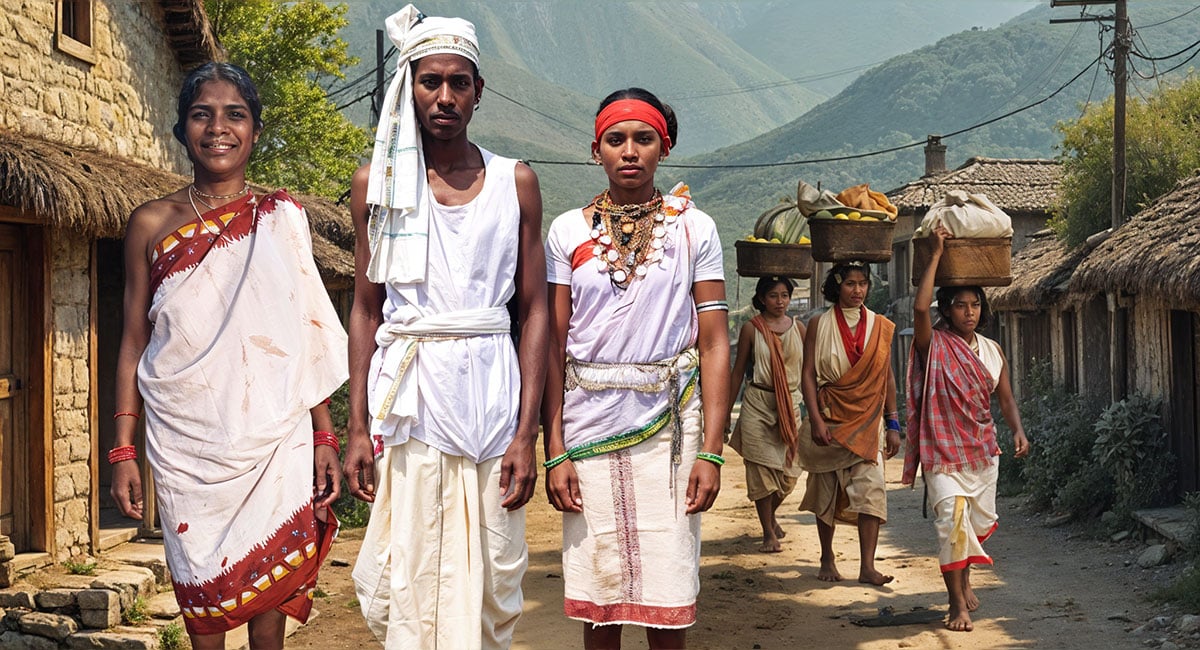The Distinctive Dress of Saura and Kondh Tribes
Odisha, a state in eastern India, is home to several indigenous tribes with distinct cultural heritages. The Saura and Kondh tribes are notable for their unique traditions, lifestyle, and clothing styles. These tribal attires are deeply rooted in their customs and reflect their connection with nature, social structures, and spiritual beliefs. Despite modern influences, these communities have preserved their traditional clothing, a vital part of their identity. This article showcases the conventional dress of the Saura and Kondh tribes in detail, highlighting their cultural significance and the role of natural resources in their attire.
Saura Tribe and Their Traditional Dress
The Saura community, also known as the Sabaras, is one of the oldest indigenous groups in Odisha. They predominantly inhabit the districts of Gajapati, Rayagada, and Koraput. The Saura people are known for their artistic heritage, particularly the vibrant Saura paintings that depict scenes from daily life, mythology, and nature. Their modest yet significant fashion sense reflects their strong spiritual ties and connection to the natural world.
Men’s Traditional Dress:
- Lower Garments: Saura men traditionally wear a simple loincloth called a dhoti, which artisans make from coarse cotton or handwoven fabric. The dhoti is often white or naturally dyed and is wrapped around the waist, extending to the knees.
- Upper Garments: Generally, Saura men do not wear upper garments. However, they drape a cotton cloth or shawl over their shoulders during special occasions such as festivals or religious ceremonies.
- Ornaments: Men accessorize their attire with beaded necklaces, metal armlets, and brass earrings. These ornaments often hold cultural and spiritual significance.
- Headgear: Older men sometimes wear turbans, particularly during community gatherings, festivals, or rituals.
Women’s Traditional Dress:
- Lower Garments: Women wear a saree-like attire made of handwoven cotton fabric. Artisans typically dye the fabric in natural colors, often with muted tones that blend harmoniously with the environment.
- Blouses & Upper Garments: Traditionally, many Saura women do not wear blouses. However, due to modern influences, some have started adopting them.
- Jewelry: Women adorn themselves with silver necklaces, beaded ornaments, and brass bangles. These accessories symbolize beauty, social status, and spiritual protection.
- Hair and Adornments: Women usually tie their hair into a neat bun and decorate it with flowers or beads to signify grace and femininity.
Significance of Colors and Patterns:
Saura textiles are characterized by natural dyes derived from plants and minerals, emphasizing their harmony with nature. The patterns often resemble the complex motifs in Saura paintings, depicting elements such as human figures, animals, and deities. These designs serve as a medium of storytelling and cultural preservation.
Kondh Tribe and Their Traditional Dress
The Kondh community is one of the largest indigenous groups in Odisha, primarily residing in the Kandhamal, Rayagada, and Kalahandi districts. They follow an agriculture-based lifestyle, perform sacred rituals, and resist outside influences. Their clothing reflects their strong cultural heritage and is crucial to their ceremonial practices.
Men’s Traditional Dress:
- Lower Garments: Kondh men typically wear a cotton dhoti, usually in white or off-white. The simplicity of this attire reflects their humble lifestyle.
- Upper Garments: People sometimes drape a cotton shawl or cloth around their shoulders, especially during social and religious gatherings.
- Ornaments: Men wear metal and bead jewelry, including necklaces, armlets, and earrings, symbolizing strength and tribal identity.
- Tattoos and Body Art: Some Kondh men have traditional tattoos on their arms and chest, representing clan identity and social status.
Women’s Traditional Dress:
- Lower Garments: Kondh women wear handwoven sarees in vibrant red, green, and blue shades. The bright colors symbolize prosperity and joy.
- Blouses and Upper Garments: Unlike the Saura women, Kondh women wear blouses, although the design remains simple and minimalistic.
- Jewelry and Accessories: Kondh women are famous for their heavy silver jewelry, including:
- Neck rings that signify marital status.
- Large nose rings, often adorned with complex designs.
- Metal anklets add to their distinctive appearance.
- Beaded ornaments enhance their elegance and tribal identity.
- Hair and Adornments: Hair is often braided and adorned with flowers or tied up in a bun with decorative pins.
Cultural and Religious Influences on Dress:
Their ritualistic traditions deeply influence the clothing of the Kondh community. Some notable examples include:
- During festivals, women wear heavily embroidered sarees with complex motifs representing their folklore.
- In marriage ceremonies, designers decorate the bridal dress with tribal symbols.
- People wear sacred beads and amulets for spiritual protection.
Role of Natural Resources in Clothing
Both the Saura and Kondh communities depend on locally available resources for their clothing and accessories. Artisans make handwoven cotton fabrics from indigenous cotton plants, ensuring their garments are both traditional and sustainable. Artists use natural dyes derived from leaves, flowers, and minerals to create rich, earthy colors that complement their surroundings.
Metal and bead ornaments, essential elements of tribal adornment, are skillfully crafted from locally sourced brass, silver, and copper materials. Additionally, people have historically used animal bones and shells as decorative elements in necklaces and earrings, further emphasizing their deep connection with nature and their resourceful use of available materials.
Final Thoughts
The traditional dress of the Saura and Kondh communities of Odisha is a beautiful blend of culture, tradition, and nature. While modernization has influenced their lifestyles, these communities continue to uphold their unique clothing styles during significant cultural events and ceremonies. Their attire is more than just clothing—it represents their heritage, beliefs, and way of life.
Efforts to preserve and promote these traditional dresses are crucial in maintaining Odisha’s rich tribal legacy. By supporting indigenous craftsmanship, promoting sustainable fashion, and raising awareness about tribal cultures, future generations can continue to appreciate and celebrate these vibrant traditions.


